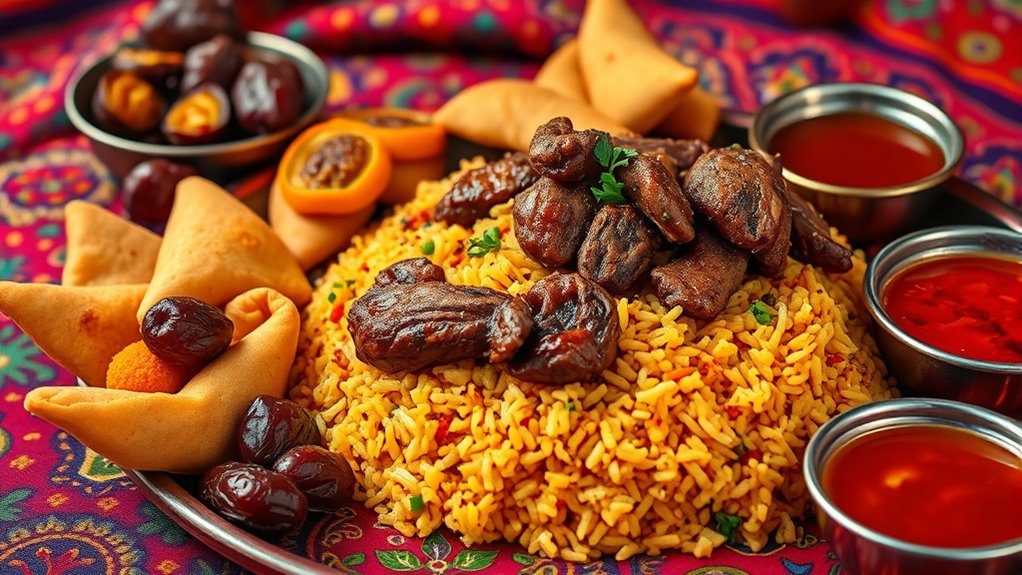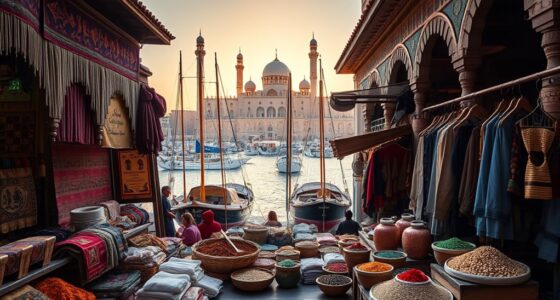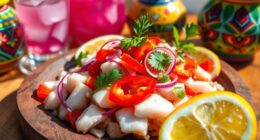Qatari cuisine reflects a blend of Bedouin traditions, coastal influences, and historic trade routes. You’ll find dishes like Machboos and Harees that use aromatic spices, rice, and slow-cooked meats, along with seafood from the Gulf. The cuisine emphasizes communal eating, hospitality, and preservation techniques like drying and fermenting. Modern influences bring fusion and innovation, but the rich heritage still shines through. Exploring more will reveal how Qatar’s history beautifully shapes its vibrant culinary scene.
Key Takeaways
- Qatari cuisine is rooted in Bedouin nomadic traditions, emphasizing portable staples like dates, grains, and slow-cooked meats.
- Seafood, especially fish and shrimp, plays a central role due to Qatar’s coastal location and Gulf waters.
- Spices such as saffron, cloves, and black lime are integral, introduced via historic trade routes, influencing flavor profiles.
- Traditional dishes like Machboos, Harees, and Shuwaa symbolize cultural celebrations and social cohesion.
- Culinary practices blend authentic methods with modern influences, including fusion cuisine and upscale dining experiences.
Foundations of Qatari Cuisine: Historical Roots and Cultural Influences

Qatari cuisine has deep roots shaped by its historical lifestyle and strategic geographic position. You’ll notice that traditional foods reflect a nomadic Bedouin way of life, emphasizing simple, portable staples like dates and grains. Coastal communities focused on seafood, especially fish and shrimp, influenced local dishes, highlighting the importance of the Gulf’s abundant waters. As a crossroads of trade, Qatar’s cuisine absorbed Persian, Indian, Levantine, and North African flavors, enriching its culinary palette. Islamic laws also play a key role, dictating the use of halal ingredients and communal dining customs. The discovery of oil in the 20th century brought economic growth, expanding ingredient diversity and further shaping the evolving culinary landscape. This blend of history and geography creates the unique foundation of Qatari cuisine. Additionally, the influence of Italian cuisine can be seen in some modern dishes, blending traditional flavors with contemporary culinary techniques.
Key Ingredients and Flavors in Traditional Dishes

Central to traditional Qatari dishes are ingredients that deliver bold flavors and hearty textures. You’ll find rice infused with saffron, cloves, and cardamom, creating aromatic, flavorful bases for many meals. Lamb and chicken are cooked slowly with spices, soaking up deep, warming tastes. Fresh seafood like tiger shrimp and hamour adds a briny, savory element, highlighting Qatar’s coastal proximity. Dates are more than a snack—they symbolize cultural heritage and provide natural sweetness in desserts and dishes. Dairy products such as laban and ghee enrich flavors and textures, often prepared using traditional methods like girba churns. These ingredients combine to create dishes with complex spice profiles, balancing richness and freshness, and reflecting Qatar’s rich history of trade, desert life, and coastal abundance. Additionally, the use of traditional cooking techniques enhances the depth and authenticity of Qatar’s culinary creations.
Iconic Qatari Meals and Their Significance

You’ll find that Machboos is more than just a meal; it’s a symbol of celebration and community gatherings in Qatar. Shuwaa, the festive roast lamb, highlights special occasions and traditional hospitality, connecting families through shared dishes. Meanwhile, dishes like Harees and Jareesh carry deep cultural significance, reflecting the history of survival and resourcefulness in Qatari society. Ensuring the reliability of traditional cooking methods helps preserve these cultural practices for future generations.
Machboos: National Celebration Dish
Machboos stands out as the heart of Qatar’s celebratory cuisine, symbolizing hospitality and communal pride. This dish combines fragrant rice, spices, and meat or fish, often prepared for festivals, weddings, and family gatherings. Its rich aroma and vibrant flavors reflect Qatar’s diverse influences and deep-rooted traditions. When you serve Machboos, you honor centuries of cultural history, bringing people together around a shared meal. The dish’s ingredients and spices are carefully selected to highlight regional flavors and symbolize prosperity. To better understand its significance, here’s a quick look:
| Ingredient | Spice | Occasion |
|---|---|---|
| Basmati rice | Saffron | Celebrations |
| Lamb or fish | Cardamom | Community gatherings |
| Nuts and dried limes | Cumin | Religious festivals |
Additionally, the preparation of Machboos often involves specific cooking techniques that enhance its aroma and flavor profile.
Shuwaa: Festive Roast Lamb
Shuwaa, a grand roast lamb dish, holds a special place in Qatari festivities and family celebrations. You likely associate it with special occasions like Eid or large gatherings, where the aroma alone signals a feast. Traditionally, you prepare Shuwaa by marinating a whole lamb with spices, then wrapping it in palm fronds or banana leaves. It’s slow-cooked underground for hours, ensuring tender, smoky meat infused with regional flavors. The process emphasizes community effort, with families sharing the work and celebrating together. When served, the lamb is often carved at the table, symbolizing unity and hospitality. Shuwaa’s significance extends beyond taste—it reflects Qatar’s rich cultural heritage, social bonds, and the importance of communal celebration in Qatari life.
Harees and Jareesh Significance
Harees and Jareesh hold a special place in Qatari cuisine because they embody the country’s historical reliance on simple, hearty foods that sustain communities through generations. These dishes reflect the Bedouin emphasis on nutritious, portable meals made from basic ingredients like wheat and grains. Harees combines ground wheat with ghee and meat or chicken, creating a creamy, filling dish often served during Ramadan and special occasions. Jareesh, cooked with wheat, chicken, and vegetables, symbolizes communal sharing and hospitality. Both dishes highlight Qatar’s cultural roots, emphasizing slow cooking and flavor from regional spices. Today, Harees and Jareesh remain cherished, connecting you to the past while still being enjoyed during festivals, family gatherings, and important celebrations. They symbolize resilience, tradition, and the spirit of Qatari hospitality. The use of traditional cooking methods ensures these dishes retain their authentic flavors and cultural significance.
Culinary Customs and Food Preparation Techniques

You’ll notice that sharing meals is central to Qatari culinary customs, with large dishes served family-style to strengthen bonds. Traditional food preservation methods, like drying fish and meats or using dried black limes, help maintain ingredients for special occasions. These practices reflect a deep respect for community and resourcefulness in food preparation. Incorporating Grocery Savings Strategies can also support families in maintaining their traditional diets while managing costs effectively.
Communal Dining Practices
| Aspect | Meaning |
|---|---|
| Sharing dishes | Builds trust and social cohesion |
| Large platters | Promotes equality and inclusiveness |
| Passing food around | Reinforces generosity and respect |
| Traditional tools | Connects to cultural heritage |
| Hospitality customs | Demonstrates welcoming spirit |
Traditional Food Preservation
Traditional Qatari food preservation techniques have played a crucial role in ensuring food security and maintaining culinary heritage, especially in a desert environment with limited access to fresh supplies year-round. You likely rely on methods like drying fish and meats to extend their shelf life, especially before modern refrigeration. Salting and smoking are common techniques for preserving seafood and meats, which you might use to prepare for times when fresh ingredients are scarce. Dried black limes are also used to flavor dishes while adding preservative qualities. Fermentation processes, such as using girba to churn milk into laban and ghee, help conserve dairy products for longer periods. These methods reflect a practical approach rooted in necessity, preserving flavors and nutrients while supporting community resilience and cultural continuity. Additionally, traditional preservation techniques often involve fermentation to enhance flavors and prolong shelf life naturally.
The Impact of Geography and Trade on Food Development
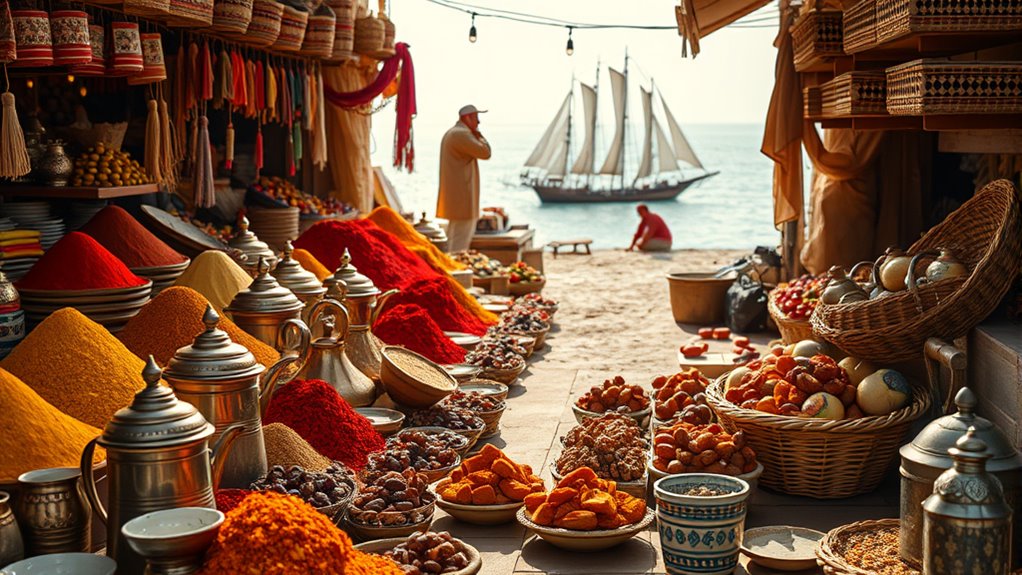
How has Qatar’s strategic location shaped its culinary landscape? Your geographic position along the Arabian Gulf has made seafood a cornerstone of local cuisine, with fresh fish and shrimp readily available. Trade routes connecting Qatar to India, Persia, and the Levant introduced exotic spices like saffron, cloves, and turmeric, enriching traditional dishes. These spices traveled through historic maritime networks, blending with Bedouin and coastal influences to create unique flavor profiles. The proximity to trade hubs also facilitated access to diverse ingredients, which broadened culinary options without replacing traditional staples. Additionally, the trade networks played a crucial role in shaping culinary exchanges, allowing Qatar to incorporate a wide array of flavors and techniques. As a result, Qatar’s cuisine reflects a fusion of desert nomad and coastal cultures, continuously evolving while remaining rooted in its geographic and trading history. This blend keeps the food vibrant, diverse, and deeply connected to its natural and historical environment.
Evolution of Qatar’s Food Scene in Modern Times
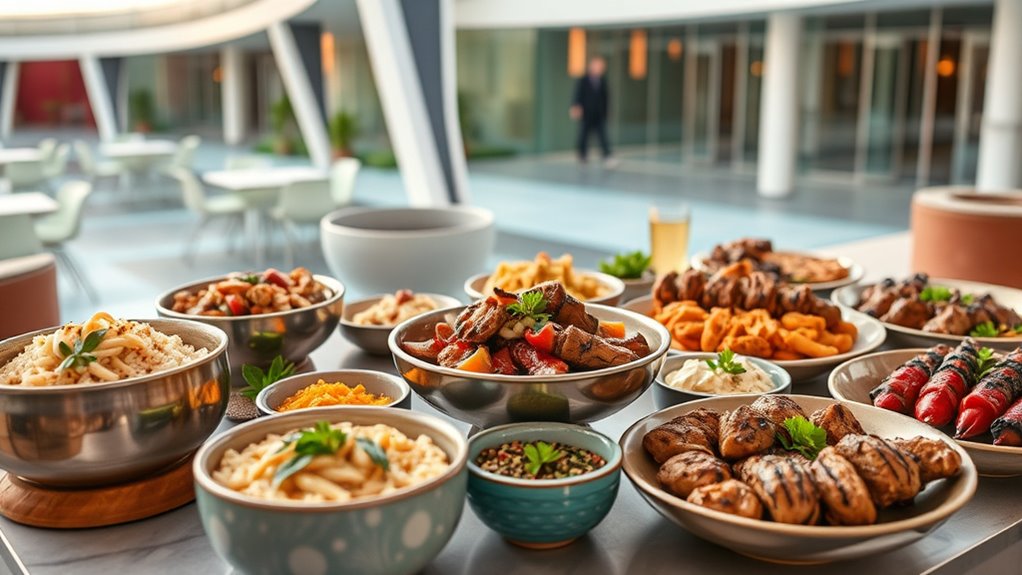
Qatar’s strategic location and rich trading history have laid a strong foundation for its modern culinary scene, which continues to evolve while honoring its roots. Today, you can enjoy traditional dishes like Machboos alongside international cuisines brought by global chefs. The rise of upscale restaurants and street food vendors reflects a dynamic mix of old and new. You might find innovative twists on classic recipes or fusion dishes blending regional flavors with contemporary techniques. This culinary growth is supported by government efforts to preserve heritage while embracing global influences. You’re encouraged to explore both traditional markets and modern eateries, where the diversity of ingredients and styles creates a vibrant, evolving food culture. Additionally, cultural preservation initiatives ensure that traditional methods and recipes remain an integral part of Qatar’s culinary identity.
Preserving Heritage Through Food and Festivals

Food and festivals serve as powerful ways to preserve and celebrate Qatar’s rich culinary heritage. When you participate in local festivals, you experience traditional dishes like Machboos and Harees, prepared with age-old techniques and regional spices. These events often feature communal meals served in large platters, reinforcing social bonds and passing down customs from generation to generation. You can witness traditional cooking methods, such as using girba for dairy or drying fish for preservation, which keep heritage alive. Festivals also highlight storytelling through food, sharing the history behind each dish and ingredient. By engaging in these celebrations, you help sustain Qatar’s culinary identity, ensuring that centuries-old flavors and customs remain vibrant and relevant in modern times. Incorporating traditional cooking techniques and proper sanitation practices further preserves the authenticity and safety of these culinary traditions.
Fusion and Innovation in Contemporary Qatari Dining
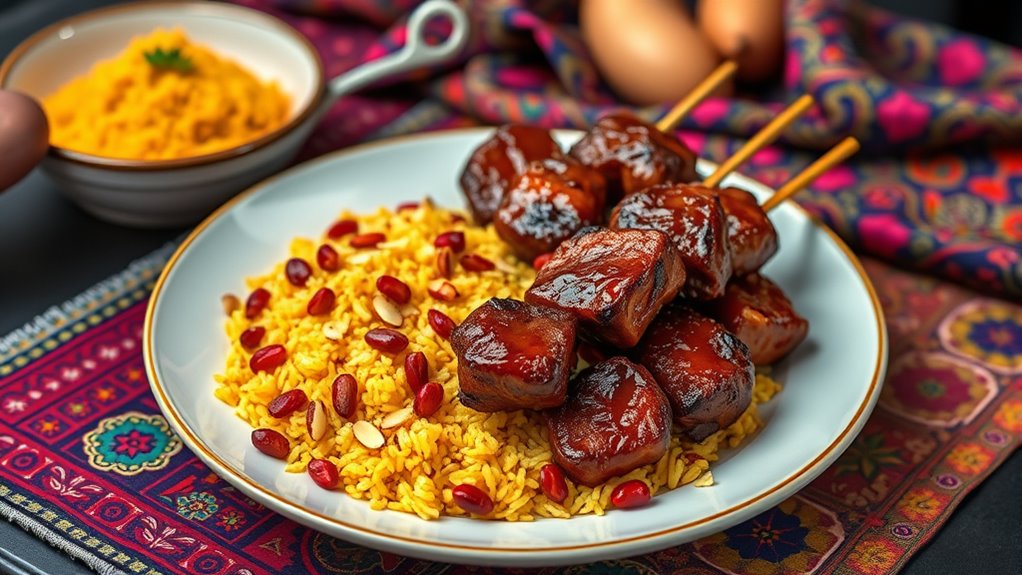
Contemporary Qatari dining seamlessly blends traditional flavors with modern culinary techniques, creating a vibrant fusion that appeals to both locals and visitors. You’ll notice chefs combining age-old ingredients like saffron, dates, and seafood with innovative methods such as molecular gastronomy and fusion cuisine. Restaurants experiment with presentation, turning classic dishes like machboos and harees into artful, contemporary creations. Global influences inspire new flavor pairings, blending Indian spices or Levantine herbs into traditional recipes. Street food vendors incorporate modern twists, offering gourmet versions of familiar favorites. This blend of tradition and innovation keeps Qatari cuisine exciting and relevant, ensuring its rich culinary heritage continues to evolve while embracing new tastes and techniques.
Frequently Asked Questions
How Do Traditional Qatari Dishes Reflect Bedouin Nomadic Life?
You see that traditional Qatari dishes reflect Bedouin nomadic life through simple, portable ingredients like dates and grains, which provide quick energy and easy storage. Meals focus on hearty, nourishing foods such as rice, lamb, and chicken, often cooked slowly for flavor. These dishes emphasize communal eating and sharing, reinforcing social bonds, and use preservation techniques suitable for a nomadic lifestyle, like drying fish and meats to last on long journeys.
What Role Do Spices Play in Authentic Qatari Cuisine?
Spices are the soul of authentic Qatari cuisine, adding depth and warmth like a storyteller weaving tales around a campfire. They’re essential for creating rich flavors in dishes like Machboos, where saffron, cardamom, and cloves transform simple ingredients into aromatic masterpieces. Imagine the aroma wafting through a bustling market—each spice carries centuries of tradition, connecting you to Qatar’s vibrant history and its people’s love for bold, shared flavors.
How Are Seafood and Coastal Ingredients Integrated Into Daily Meals?
You incorporate seafood and coastal ingredients into your daily meals by emphasizing fresh fish, shrimp, and other seafood staples from the Gulf. You might prepare dishes like Machboos with fish or serve grilled seafood alongside rice and vegetables. Coastal ingredients are also used in stews and salads, highlighting their importance in your cuisine. These ingredients reflect Qatar’s seaside lifestyle and are central to both everyday meals and special occasions.
In What Ways Have Modern Influences Changed Traditional Recipes?
Modern influences have transformed traditional recipes by blending local ingredients with international techniques and presentation styles. You now find innovative dishes that fuse traditional flavors with global cuisine, like contemporary seafood dishes or reimagined rice-based meals. Chefs incorporate new cooking methods and trendy ingredients, making the cuisine more diverse and appealing. Despite these changes, you can still enjoy classic dishes like Machboos and Majboos, which remain central to Qatar’s culinary identity.
What Are Unique Qatari Food Customs During Festivals and Celebrations?
During festivals, you’ll find that food customs are the heart of celebration, like a vibrant tapestry woven with tradition. You’re often invited to communal feasts featuring dishes like Machboos and Ghuzi, served in large platters to share. It’s customary to prepare special sweets and dates, symbolizing hospitality. Guests keenly gather around, savoring rich flavors, reinforcing bonds and honoring heritage through shared meals that turn gatherings into unforgettable moments.
Conclusion
As you explore Qatar’s rich culinary tapestry, you’ll find that its flavors gently whisper stories of history, trade, and tradition. Through every bite, the nation’s heritage quietly endures, blending age-old customs with modern innovation. Embrace these subtle nuances, and you’ll discover a world where food becomes a graceful dance—honoring the past while softly stepping into the future. In Qatar, every meal gently celebrates a timeless cultural symphony.

